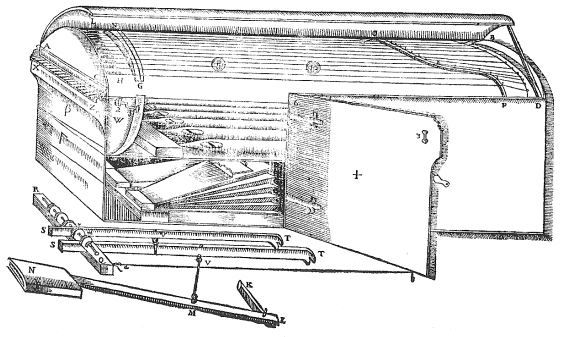
Michael Praetorius described the claviorgan in Syntagma Musicum II, De organographia, 1619 as a keyboard instrument in which strings and pipes ‘sound together to produce a pleasing sound’.
Athanasius Kircher’s Musurgia Universalis (1650) contains a description and this technical drawing of a claviorgan.

Musurgia universalis, sive Ars magna consoni et dissoni, Rome, 1650. Translation by A. Hirsch as Philosophischer Extract und Auszug aus dess Welt-berühmten teutschen Jesuiten Athanasii Kircheri von Fulda Musurgia universali, Schwäbisch Hall, 1662
In the 16th century spinets or virginals
were built ‘with pipes undernethe’ and full-size harpsichords with positive
organs incorporated were used in northern Europe. This illustration shows the
lid painting of the Wismayer spinet built for the Nuremberg patrician Lucas
Friedrich Behaim. The principal foreground group (representing Autumn) depicts
four string players surrounding a claviorgan. The instrument has two manuals, or
is a spinet placed upon an organ. Whether or not the instrument is strictly a
claviorgan, the keyboards are shown being played simultaneously and in ensemble
with the strings.

Lid painting by Frederik van Valckenborch or Falckenberg, (ca.1570-1623), The Four Seasons (1619). Paul Wismayer Virginals, Germanisches Nationalmuseum, Nüremberg.
Source: Terence Charlston, ‘An instrument in search of
its repertoire? The Theewes claviorgan and its use in the performance of
sixteenth- and seventeenth-century keyboard music.’ The RCO Journal,
March 2009, pp. 27–44.
This article explores the style and performance practices of 16th- and
17th-century keyboard music from the perspective of the claviorgan.
For further information about the clavichorgan see the Pipes and Strings Facebook page run by Eleanor Smith